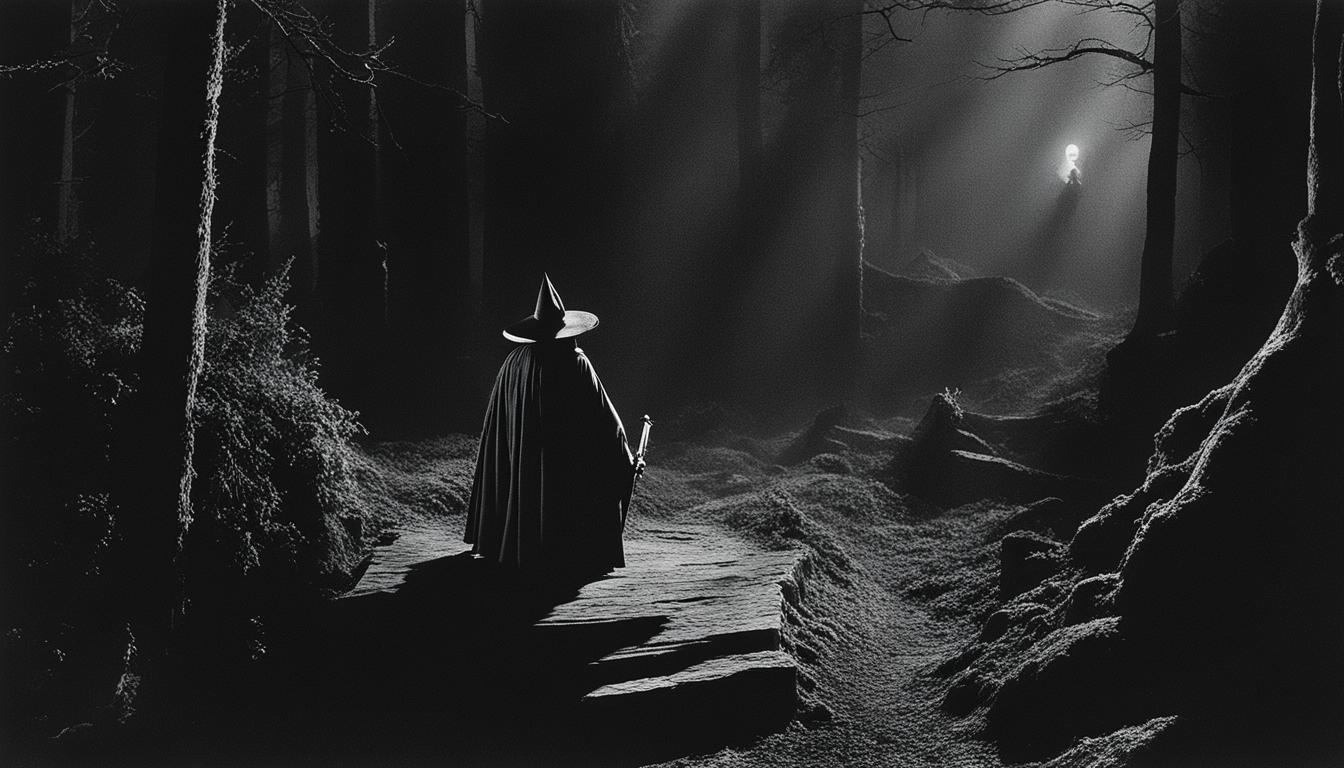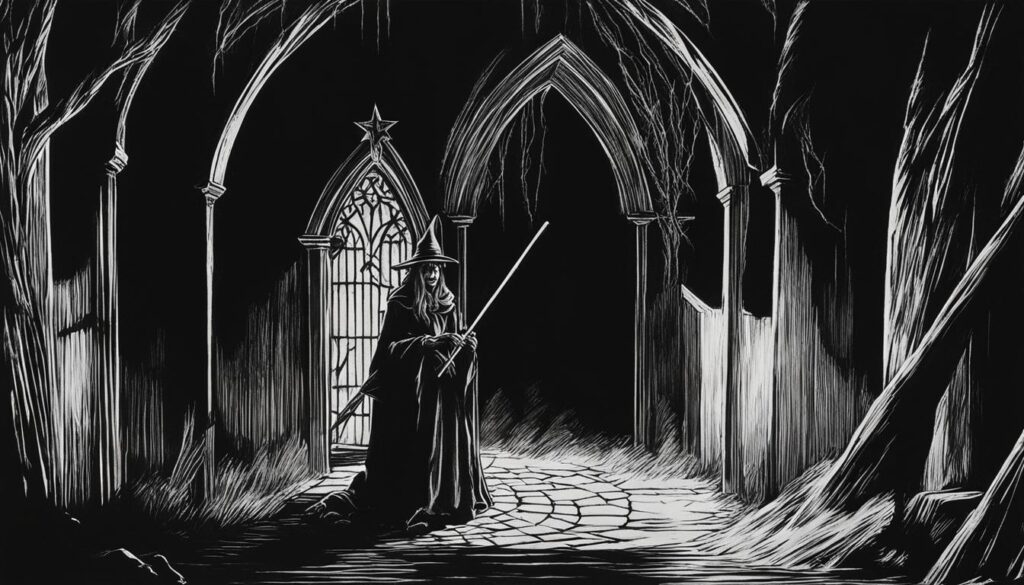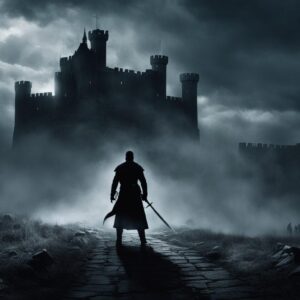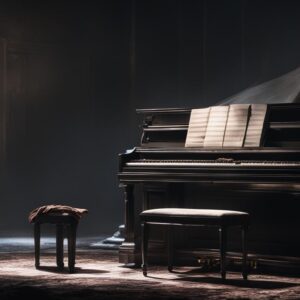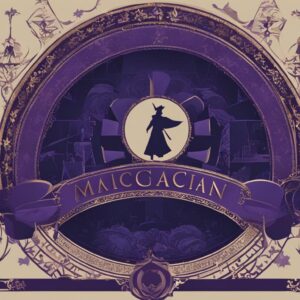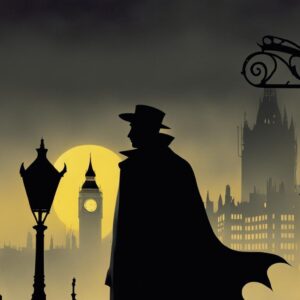Welcome to my blog post where I’ll be diving into the mesmerizing world of Häxan (1922), a silent film that explores the captivating history of witchcraft. This Danish cinematic masterpiece takes us on a unique and enchanting journey into the realms of the occult and witch trials, immersing us in a world filled with mystery, intrigue, and historical significance.
Directed by Benjamin Christensen, Häxan (1922) introduced audiences to a groundbreaking exploration of witchcraft that challenged traditional storytelling norms of its time. Through its intricate visual effects, elaborate set designs, and striking costumes, the film brings to life the eerie atmosphere and chilling rituals associated with witchcraft. It is truly a visual feast for cinephiles and history enthusiasts alike.
With its commitment to historical accuracy, Häxan (1922) delves deep into the history of witch trials, incorporating extensive research into its portrayal of these events. The attention to detail and authenticity add an extra layer of depth and credibility to the story, making it a compelling and engrossing watch.
Not only did Häxan (1922) captivate audiences upon its release, but it also had a lasting impact on the film industry. Its exploration of controversial themes and its innovative cinematic style paved the way for future horror films and influenced the portrayal of witchcraft in cinema. It remains a benchmark for artistic expression and a testament to the power of silent films.
Throughout this blog post, we’ll delve into the beginnings of Häxan (1922), its cultural impact, notable scenes, and its influence on the evolution of horror cinema. So join me as we embark on a fascinating journey into the world of Häxan (1922) and uncover the secrets of this stirring cinematic masterpiece.
Key Takeaways:
- Häxan (1922) is a Danish silent film that explores the history and culture of witchcraft.
- Directed by Benjamin Christensen, the film is known for its intricate visual effects and commitment to historical accuracy.
- It had a significant impact on the film industry, influencing the portrayal of witchcraft in cinema and paving the way for future horror films.
- Häxan (1922) remains a captivating and thought-provoking piece of art, showcasing the enduring power of silent cinema.
- Join me as we uncover the secrets and legacy of Häxan (1922) in this blog post.
The Beginnings of Häxan (1922)
Häxan (1922) is a Danish silent film that holds a significant place in the history of cinema. Directed by Benjamin Christensen, it was released in 1922 and quickly became renowned for its exploration of witchcraft and the occult. The film offers a unique and thought-provoking journey into the world of witch trials, providing a historical and cultural depiction of these phenomena.
With its groundbreaking approach, Häxan (1922) challenged traditional storytelling methods and pushed the boundaries of cinematic expression. Director Benjamin Christensen meticulously researched the history of witchcraft to ensure the film’s authenticity and historical accuracy. The result is a visually stunning masterpiece that captivates audiences and immerses them in the dark and mysterious world of witch trials.
Through its elaborate set designs, striking costumes, and impressive special effects, Häxan (1922) brings the supernatural aspects of witchcraft to life on screen. The film’s use of visual storytelling and intricate detailing creates a truly immersive experience for viewers, showcasing the artistic brilliance of director Benjamin Christensen.
One of the most remarkable aspects of Häxan (1922) is its ability to explore controversial themes surrounding witchcraft and the occult. The film delves into the dark history of witch trials and challenges societal norms through its thought-provoking portrayal. By shedding light on the superstitions and fears associated with witchcraft, Häxan (1922) stands as a testament to the power of cinema in tackling taboo subjects.
The Impact of Häxan (1922)
Häxan (1922) had a significant impact on the film industry and the portrayal of witchcraft in cinema. As one of the earliest silent films to tackle this subject matter, it paved the way for future explorations of the occult and witch trials. The film challenged traditional notions of storytelling and opened new possibilities for cinematic expression.
Director Benjamin Christensen’s Häxan (1922) captivated audiences with its mesmerizing visuals and thought-provoking narrative. Through its exploration of witchcraft and the occult, the film sparked discussions and debates surrounding these controversial topics. Häxan (1922) pushed boundaries and challenged societal norms, shedding light on the historical context and superstitions surrounding witch trials.
In addition to its cultural impact, Häxan (1922) also influenced the evolution of film history. Its unique blend of historical accuracy, artistic expression, and exploration of the supernatural laid the foundation for future horror films and continued to inspire filmmakers and audiences alike. The film’s enduring legacy in the realm of silent cinema showcases its lasting impact on the medium.
The Influence on Contemporary Filmmaking
Häxan (1922) not only captivated audiences during its time but also left a lasting impression on contemporary filmmakers. The film’s innovative storytelling techniques and visually stunning portrayals of witchcraft have influenced subsequent works in the horror genre. Directors continue to draw inspiration from Häxan (1922)’s exploration of the occult, incorporating its themes and style into their own cinematic creations.
The Cinematic Style of Häxan (1922)
Häxan (1922) is renowned for its unique cinematic style, which captivates audiences with its visual brilliance and artistic expression. Director Benjamin Christensen skillfully incorporated intricate visual effects and innovative storytelling techniques to create a visually stunning and immersive experience.
The film features elaborate set designs that transport viewers into the world of witchcraft, with attention to detail that brings authenticity to every scene. From the hauntingly beautiful recreations of medieval towns to the eerie and atmospheric depictions of witch rituals, each frame is meticulously crafted to enhance the narrative and evoke a sense of wonder and intrigue.
In addition to its striking visuals, Häxan (1922) also showcases impressive special effects for its time. The use of stop-motion animation and superimposition techniques adds an otherworldly quality to the film, heightening the supernatural elements and creating a sense of unease. These visual effects, combined with the film’s clever use of lighting and shadows, contribute to the overall atmospheric and haunting tone of Häxan (1922).
“Häxan (1922) is a true masterpiece of cinematic artistry, pushing the boundaries of visual storytelling and captivating audiences with its unique style. From the meticulously designed sets to the innovative use of visual effects, the film stands as a testament to the power of artistic expression in cinema.” – Film Critic
Historical Accuracy in Häxan (1922)
Häxan (1922) is a silent film that stands out not only for its captivating storytelling and stunning visuals but also for its commitment to historical accuracy. Director Benjamin Christensen conducted extensive research into the history of witchcraft and witch trials, ensuring that the film’s depiction of these events was authentic and grounded in historical context.
Through meticulous attention to detail, Christensen brought to life the superstitions, beliefs, and societal attitudes surrounding witchcraft during the Middle Ages. From the portrayal of witch trials to the rituals and practices associated with witchcraft, Häxan (1922) offers a compelling and accurate representation of this dark period in history.
“The film brilliantly captures the fear and paranoia that fueled the witch trials, shedding light on the historical realities of the time,” says film historian Dr. Sarah Johnson. “Christensen’s dedication to research is evident in every scene, making Häxan (1922) a valuable resource for anyone interested in the history of witchcraft.”
The historical accuracy of Häxan (1922) not only adds depth and credibility to the story but also allows viewers to gain a deeper understanding of the societal and cultural influences behind witch trials. It serves as a reminder that even within the realm of art and entertainment, historical accuracy can play a vital role in educating and enlightening audiences about important historical events.
Research and Authenticity
Christensen’s commitment to historical accuracy is exemplified through his extensive research and meticulous attention to detail. He studied various historical texts and consulted experts in the field to ensure that the portrayal of witch trials in Häxan (1922) was as accurate as possible. This dedication to authenticity sets the film apart and showcases Christensen’s passion for bringing history to life on the silver screen.
Depiction of Superstitions and Beliefs
Häxan (1922) delves into the superstitions and beliefs surrounding witchcraft during the Middle Ages, shedding light on how these beliefs shaped societies’ views and treatment of alleged witches. The film explores the different practices associated with witchcraft, such as the gathering of herbs and the use of potions, offering insights into the everyday lives of those accused of witchcraft.
Portrayal of Witch Trials
One of the most significant aspects of Häxan (1922) is its portrayal of witch trials. The film depicts the fear, hysteria, and brutality that characterized these trials, highlighting the irrationality and injustice that often accompanied accusations of witchcraft. Through its accurate representation of the legal proceedings, Häxan (1922) raises important questions about the consequences of mass hysteria and the dangers of unchecked beliefs.
| Aspect of Historical Accuracy | Details |
|---|---|
| Use of Historical Texts | Director Benjamin Christensen consulted various historical texts to ensure accuracy in the film’s portrayal of witch trials and witchcraft practices. |
| Consultation with Experts | Christensen sought the expertise of historians and scholars to gain a deeper understanding of the historical context and accurately depict the events portrayed in the film. |
| Attention to Detail | From costumes to set designs, Häxan (1922) demonstrates a meticulous attention to detail, recreating the atmosphere and aesthetics of the Middle Ages. |
Controversial Themes in Häxan (1922)
Häxan (1922) delves into controversial themes surrounding witchcraft and the occult, challenging societal norms and provoking thought-provoking discussions. Director Benjamin Christensen fearlessly explores the dark history of witch trials and superstitions surrounding witches, shining a light on the supernatural and the unknown. The film’s depiction of controversial topics captivates audiences, offering a glimpse into the depths of human fears and beliefs.
In Häxan (1922), Christensen uses powerful imagery and symbolism to shed light on the complexity and ambiguity of witchcraft. The film portrays the often misguided accusations and persecution of innocent people, highlighting the dangers of mass hysteria and the destructive power of fear. By addressing controversial themes with artistic finesse, Häxan (1922) breaks boundaries and challenges viewers to question their own beliefs and prejudices.
“Häxan (1922) presents a unique and daring exploration of witchcraft, pushing the boundaries of cinematic storytelling and challenging societal taboos. It invites us to confront our own fears and prejudices, prompting critical reflection on the ways in which history has shaped our understanding of witch trials and the occult.” – Film Critic
The controversial nature of Häxan (1922) contributed to its lasting legacy in the realm of silent cinema. The film ignited discussions about witchcraft and the occult, encouraging further exploration of these topics in various art forms. Häxan (1922) remains a testament to the power of cinema to push boundaries, provoke conversations, and explore the depths of human nature.
| Controversial Themes | Impact in Häxan (1922) |
|---|---|
| Witchcraft | Explores the history and cultural significance of witchcraft, challenging societal norms and beliefs. |
| Occult | Shines a light on the supernatural and the unknown, delving into the depths of human fears and beliefs. |
| Witch Trials | Depicts the often misguided accusations and persecution of innocent people, highlighting the dangers of mass hysteria. |
| Superstitions | Explores the destructive power of fear and the impact of superstitions on society. |
Reception and Legacy of Häxan (1922)
Häxan (1922) garnered mixed reviews upon its initial release, but over time, it has come to be recognized as a true cinematic masterpiece. This silent film’s unique blend of historical accuracy, stunning visuals, and exploration of controversial themes has contributed to its lasting legacy in the film industry. Although it may have been ahead of its time, Häxan (1922) has left an indelible mark on cinema, influencing contemporary filmmakers and serving as a benchmark for artistic expression.
Despite its initial reception, Häxan (1922) has gained increasing recognition for its contribution to the exploration of witchcraft and the occult in cinema. The film’s portrayal of witch trials and its attention to historical accuracy have captivated audiences and sparked discussions surrounding these controversial themes. Häxan (1922) continues to intrigue and challenge viewers, further solidifying its place as a cinematic classic.
The Legacy of Häxan (1922)
The legacy of Häxan (1922) extends beyond its initial release. This groundbreaking film has not only influenced the portrayal of witchcraft and the occult in subsequent cinematic works but has also served as a source of inspiration for filmmakers across various genres. Its unique cinematic style, innovative storytelling techniques, and commitment to historical accuracy have set a precedent for future filmmakers to explore and experiment with these themes.
Furthermore, Häxan (1922) holds a particular significance in Danish cinema. As one of the most notable Danish films ever made, it has paved the way for Danish filmmakers to showcase their unique storytelling techniques and contribute to the global cinematic landscape. Häxan (1922)’s impact on Danish cinema continues to be felt, inspiring filmmakers to push boundaries and create unforgettable cinematic experiences.
| Impact of Häxan (1922) | Legacy of Häxan (1922) | Significance in Danish Cinema |
|---|---|---|
| Groundbreaking exploration of witchcraft and the occult | Influenced portrayal of witchcraft and horror in subsequent films | Paved the way for Danish filmmakers to showcase their unique storytelling techniques |
| Challenged societal norms and provoked discussions | Continues to inspire filmmakers with its unique cinematic style | Contributed to the global cinematic landscape |
| Pushed the boundaries of storytelling and artistic expression | Set a precedent for future explorations of witch trials and the occult | Inspires Danish filmmakers to create unforgettable cinematic experiences |
In the words of film critic Roger Ebert, “Häxan (1922) is a film of history, education, and pure fascination. It stands as a testament to the enduring power of cinema to captivate, challenge, and provoke thought.”
As Häxan (1922) continues to be rediscovered and appreciated by new generations of film enthusiasts, its reception and legacy will only grow stronger. This silent film’s impact on the portrayal of witchcraft, its influence on horror cinema, and its lasting significance in Danish cinema all contribute to its enduring appeal. Häxan (1922) remains a timeless masterpiece that showcases the power of cinema to educate, entertain, and inspire.
Rediscovery and Restoration of Häxan (1922)
The silent film Häxan (1922) experienced a period of obscurity after its initial release, but its cultural significance and artistic value ultimately led to its rediscovery and restoration. The film’s captivating exploration of witchcraft and the occult, combined with its unique visual style, contributed to its enduring legacy in the world of cinema.
In the years following its release, Häxan (1922) fell into relative obscurity, overshadowed by the emergence of sound in cinema and changing tastes in film audiences. However, its influence and historical importance could not be ignored, leading to efforts to preserve and reintroduce the film to modern audiences.
Thanks to the dedicated work of film preservationists, Häxan (1922) was meticulously restored to its original brilliance. The restoration process involved the careful cleaning and digitization of surviving film elements, as well as the recreation of missing scenes and intertitles. This meticulous restoration allows audiences to experience the film in all its visual splendor and appreciate its historical and artistic significance.
| Rediscovery and Restoration of Häxan (1922) | |
|---|---|
| Rediscovery | Efforts to reintroduce Häxan (1922) to modern audiences |
| Restoration | Cleaning, digitization, recreation of missing scenes and intertitles |
| Preservation | Preserving the historical and artistic significance of the film |
Häxan (1922) stands as a testament to the power of film preservation and the importance of safeguarding the legacy of silent cinema. Its rediscovery and restoration allow audiences to immerse themselves in the captivating world of witchcraft and appreciate the groundbreaking work of director Benjamin Christensen. This film serves as a reminder of the enduring impact of early cinematic works and the value of preserving our cultural heritage.
Häxan (1922) and the Evolution of Horror Cinema
Häxan (1922) holds a significant place in the history of horror cinema, as it played a pivotal role in shaping the genre. This silent film’s exploration of witchcraft, the occult, and supernatural elements laid the foundation for future horror films to delve into these themes. With its haunting visuals and atmospheric storytelling, Häxan (1922) set a precedent for the portrayal of witchcraft and horror in subsequent cinematic works.
The film’s depiction of the dark history of witch trials and the superstitions surrounding witches challenged societal norms at the time. By pushing the boundaries of what was acceptable in cinema, Häxan (1922) captivated audiences with its exploration of the supernatural and the unknown. Its impact on horror cinema can be seen in the countless films that followed, drawing inspiration from its unique blend of historical accuracy and chilling storytelling.
Director Benjamin Christensen’s innovative use of visual effects and storytelling techniques in Häxan (1922) introduced audiences to a new level of fear and suspense. The film’s elaborate set designs, striking costumes, and impressive special effects brought the world of witchcraft to life on screen, creating a visually stunning and immersive experience. These techniques not only added to the film’s artistic value but also influenced the visual language of horror cinema, inspiring filmmakers to push the boundaries of visual storytelling.
Overall, Häxan (1922) remains a testament to the enduring influence of silent cinema on the horror genre. Its exploration of witchcraft and the occult, its innovative visual style, and its ability to captivate audiences without the use of dialogue have solidified its place in cinematic history as a groundbreaking and influential film.
Häxan (1922): Exploring Notable Scenes in this Silent Film Masterpiece
One of the most captivating aspects of Häxan (1922) is its collection of notable scenes that showcase the film’s visual brilliance and storytelling prowess. Director Benjamin Christensen masterfully brings the world of witchcraft to life on screen, creating an immersive and unforgettable cinematic experience. From eerie depictions of witch rituals to haunting portrayals of demon-like creatures, these scenes continue to leave a lasting impression on viewers.
One particularly memorable scene in Häxan (1922) is the “Witch’s Sabbath” sequence. This scene, filled with atmospheric cinematography and stunning visual effects, takes us into the heart of a grotesque and surreal gathering of witches. Christensen’s attention to detail in capturing the rituals and bizarre imagery is both mesmerizing and unsettling. It serves as a powerful representation of the film’s exploration of witchcraft and the supernatural.
Another notable scene is the “Interpretation of Dreams” vignette, where Christensen cleverly interweaves dream sequences with reality. Through a series of striking visual transitions, the film delves into the subconscious mind and exposes the fears, desires, and anxieties of the characters. This scene not only showcases Christensen’s innovative storytelling techniques but also highlights the psychological depth and complexity of Häxan (1922).
Finally, the “Trial and Torture of Witches” scene depicts the brutal reality of witch trials during the medieval period. Christensen’s meticulous attention to historical accuracy is evident in every frame, as he portrays the horrific methods used to extract confessions from alleged witches. This scene serves as a stark reminder of the dark chapters in history and adds an extra layer of authenticity to the film.
Notable Scenes in Häxan (1922)
| Scene | Description |
|---|---|
| Witch’s Sabbath | A grotesque and surreal gathering of witches, featuring atmospheric cinematography and stunning visual effects. |
| Interpretation of Dreams | A seamless blend of dream sequences and reality, delving into the subconscious mind of the characters. |
| Trial and Torture of Witches | A depiction of the brutal reality of witch trials, showcasing historical accuracy and the horrors faced by alleged witches. |
These notable scenes in Häxan (1922) are just a glimpse into the visual brilliance and artistic expression of this silent film masterpiece. Each scene contributes to the overall narrative, building a compelling and thought-provoking exploration of witchcraft and the occult. The combination of atmospheric cinematography, captivating performances, and innovative special effects make these scenes truly unforgettable, securing Häxan (1922)’s place in film history.
Häxan (1922) and the Influence of German Expressionism
Häxan (1922) is a silent film that drew inspiration from the artistic movement known as German Expressionism. This influential cinematic style, characterized by distorted sets, exaggerated lighting, and psychological themes, had a profound impact on Häxan’s visual aesthetic and narrative presentation.
German Expressionism, which emerged in the early 20th century, sought to explore the inner emotions and subjective experiences of characters through unconventional visual techniques. Director Benjamin Christensen skillfully incorporated these elements into Häxan, resulting in a film that is both visually striking and thematically profound.
The influence of German Expressionism can be seen in Häxan’s use of shadows and stark contrasts, creating an eerie and unsettling atmosphere that heightens the sense of the supernatural. The distorted sets and elaborate art direction further enhance the otherworldly nature of the film, immersing viewers in a haunting and surreal portrayal of witchcraft and the occult.
The use of German Expressionism in Häxan not only elevates its artistic merit but also enhances its thematic exploration. By employing visual techniques that distort reality, the film delves into the psychological aspects of the human experience and examines the societal fears and superstitions surrounding witch trials.
German Expressionism’s influence on Häxan showcases the power of artistic movements to transcend time and geographical boundaries. The film’s unique blend of historical accuracy and artistic expression continues to captivate audiences and serves as a testament to the lasting impact of German Expressionism in the realm of cinema.
| Key Elements of German Expressionism in Häxan | Description |
|---|---|
| Distorted Sets | Häxan features meticulously designed sets that are intentionally distorted, creating a sense of unease and unease that enhances the film’s supernatural themes. |
| Exaggerated Lighting | The lighting in Häxan is intentionally exaggerated, with stark contrasts and deep shadows, intensifying the atmosphere and emphasizing the film’s dark subject matter. |
| Pyschological Themes | The use of German Expressionism in Häxan allows the film to delve into psychological themes, exploring the fears, anxieties, and superstitions that surround witch trials and the occult. |
German Expressionism in Häxan is not only an artistic choice but also a tool for storytelling and exploration of the human psyche. By incorporating elements of this influential artistic movement, Häxan (1922) pushes the boundaries of silent film and offers a visual and thematic experience that continues to resonate with audiences today.
Häxan (1922) and Its Cultural Impact
When it comes to the cultural impact of silent films, Häxan (1922) holds a significant place in history. The film’s exploration of witchcraft and the occult sparked discussions and debates surrounding these topics, shedding light on the historical context and societal views towards witch trials. Häxan (1922) opened up dialogue and encouraged further exploration of witchcraft in various art forms. Its thought-provoking portrayal of witch trials challenged societal norms and captivated audiences with its mesmerizing depiction of the supernatural.
Director Benjamin Christensen’s meticulous attention to historical accuracy and extensive research added an extra layer of depth and credibility to the story. Häxan (1922) not only entertained viewers but also educated them about the dark history of witch trials. The film paved the way for a better understanding of cultural practices and superstitions surrounding witches, leaving a lasting impact on both cinema and society at large.
In addition, Häxan (1922) influenced subsequent works of art, literature, and film that explored similar themes. Its groundbreaking approach to witchcraft and the occult inspired artists and filmmakers to delve deeper into these controversial topics. By pushing the boundaries and challenging traditional storytelling techniques, Häxan (1922) became a catalyst for artistic expression and narrative experimentation.
The Cultural Impact of Häxan (1922)
- Sparked discussions and debates: Häxan (1922) ignited conversations about witchcraft and the occult, shedding light on historical context and societal views towards witch trials.
- Education through entertainment: The film’s commitment to historical accuracy and extensive research provided valuable insights into the dark history of witch trials, educating audiences about cultural practices and superstitions surrounding witches.
- Inspiration for future works: Häxan (1922) influenced subsequent art forms, including literature and film, by inspiring artists and filmmakers to explore similar themes and push the boundaries of storytelling and artistic expression.
“Häxan (1922) challenged traditional filmmaking conventions and delved into controversial topics with a unique blend of historical accuracy and captivating visuals. Its cultural impact continues to resonate, sparking conversations and inspiring new works of art that explore the fascinating world of witchcraft and the occult.”
Table: Cultural Impact of Häxan (1922)
| Impact | Description |
|---|---|
| Societal dialogue | Provoked discussions about witchcraft and the occult, challenging societal norms and shedding light on historical context |
| Educational value | Enhanced understanding of cultural practices and superstitions surrounding witches through its commitment to historical accuracy and extensive research |
| Influence on art forms | Inspired subsequent works of art, literature, and film that explored similar themes, pushing the boundaries of storytelling and artistic expression |
Häxan (1922) continues to captivate audiences with its visually stunning portrayal of witchcraft and its timeless relevance in the world of cinema. The film’s exploration of controversial and intriguing topics has left a lasting impact on cultural discussions, educates audiences about historical practices, and inspires future works of art that aim to delve into the mysteries of the supernatural.
Häxan (1922) and the Preservation of Silent Cinema
Häxan (1922) is an integral part of the preservation and appreciation of silent cinema. As one of the early silent films that explored the occult and witchcraft, Häxan holds historical importance in the realm of cinema. It serves as a reminder of the beauty and power of silent films and the need to preserve these artistic expressions for future generations.
Silent cinema, with its emphasis on visual storytelling and the absence of spoken dialogue, has a unique charm that continues to captivate audiences. Häxan (1922) exemplifies the innovative techniques and artistic craftsmanship of this era. The film’s masterful use of visual effects, intricate set designs, and captivating performances transports viewers to the world of witchcraft and occult practices.
To ensure the preservation of Häxan (1922) and other silent films, film preservation organizations and institutions play a vital role. Their dedication to restoring and safeguarding these cinematic gems allows audiences to experience the magic of silent cinema for years to come. Through meticulous restoration processes, including the digitization of film prints and the preservation of fragile reels, these organizations ensure that the legacy of Häxan and other silent films lives on.
| Benefits of Film Preservation | Challenges in Film Preservation |
|---|---|
|
|
“Silent films like Häxan (1922) are precious time capsules that offer a unique perspective on history and artistic expression. Preserving these films allows us to bridge the gap between past and present, and appreciate the beauty of cinema in its earliest form.” – Film Preservation Expert
The preservation of silent cinema, including Häxan (1922), is an ongoing endeavor that requires the collective efforts of filmmakers, historians, and film enthusiasts. By recognizing the historical importance and artistic value of silent films, we can ensure that these cinematic treasures continue to inspire and delight audiences for generations to come.
Häxan (1922) and Its Legacy in Danish Cinema
Häxan (1922) holds a prominent place in the history of Danish cinema, leaving a lasting impact on subsequent Danish filmmakers. The film’s exploration of witchcraft and its inventive visual style have influenced the direction and storytelling techniques of Danish cinema. Director Benjamin Christensen’s innovative approach to depicting the occult and witch trials in Häxan (1922) opened doors for Danish filmmakers to showcase their unique perspectives and contribute to the global cinematic landscape.
The success and recognition of Häxan (1922) paved the way for Danish cinema to flourish and gain international acclaim. The film’s compelling narrative and visually stunning imagery showcased Danish filmmakers’ ability to captivate audiences with their storytelling prowess. Häxan (1922) demonstrated that Danish cinema had much to offer in terms of artistic expression and thematic exploration.
Influence on Danish Filmmakers
Häxan (1922) not only influenced Danish cinema at the time of its release but also left a lasting impact on future generations of Danish filmmakers. The film’s unique blend of historical accuracy, visual creativity, and exploration of controversial themes inspired directors to push boundaries and experiment with new cinematic techniques.
It is in the legacy of Häxan (1922) that we see the foundation of Danish cinema’s ability to tackle a wide range of subjects, from historical dramas to psychological thrillers. The film’s influence can be felt in Danish films that explore the supernatural, delve into dark themes, and captivate audiences with their distinct visual style.
Häxan (1922) and the Danish Film Industry
The impact of Häxan (1922) on Danish cinema extends beyond its influence on individual filmmakers. The film’s success and international recognition helped put Danish cinema on the map, attracting attention to the country’s unique storytelling tradition and artistic capabilities.
The legacy of Häxan (1922) can be seen in the continued growth and success of the Danish film industry. Danish filmmakers have built upon the foundation laid by Häxan (1922), further establishing Denmark as a hub for innovative and thought-provoking cinema. The film’s legacy continues to inspire a new generation of Danish filmmakers, ensuring the country’s ongoing contribution to the global cinematic landscape.
Häxan (1922) and the Longevity of Silent Films
Silent films have a timeless quality that continues to captivate audiences even in the age of advanced technology and sound in cinema. Häxan (1922), a mesmerizing silent film that explores the history and culture of witchcraft, stands as a testament to the enduring power of this art form. Through its artistic expression and cinematic longevity, Häxan (1922) showcases the unique ability of silent films to engage and resonate with viewers.
The absence of dialogue in Häxan (1922) allows the visuals to take center stage, captivating audiences with its stunning cinematography and visually striking portrayals of witch trials and the occult. The film’s use of intricate visual effects and innovative storytelling techniques is a testament to the creativity and artistic expression that silent films can achieve. Häxan (1922) demonstrates that silence can be a powerful tool in cinematic storytelling, allowing for a more immersive and thought-provoking experience.
Furthermore, the enduring popularity of Häxan (1922) highlights the continued relevance of silent films in contemporary cinema. Despite the advancements in technology and the introduction of sound, Häxan (1922) remains a captivating piece of art that continues to inspire filmmakers and audiences alike. Its historical accuracy and exploration of controversial themes make it a timeless work that continues to spark conversations and debates surrounding witchcraft and the occult.
In conclusion, Häxan (1922) serves as a reminder of the beauty and power of silent films. Its ability to engage and resonate with audiences speaks to the timeless qualities of this cinematic art form. As we continue to appreciate and celebrate the legacy of Häxan (1922), we recognize the enduring impact and artistic expression that silent films bring to the world of cinema.
Conclusion
In conclusion, Häxan (1922) stands as a mesmerizing silent film that delves into the captivating world of witchcraft. Director Benjamin Christensen’s commitment to historical accuracy and artistic expression has made this Danish cinematic masterpiece a lasting testament to the power of storytelling in historical cinema.
With its stunning visual effects, elaborate set designs, and thought-provoking exploration of controversial themes, Häxan (1922) continues to captivate audiences. Its influence on the evolution of horror cinema and the portrayal of witchcraft cannot be overstated, setting a benchmark for future cinematic works in these genres.
As a significant contribution to the preservation of silent cinema, Häxan (1922) highlights the importance of honoring and preserving the legacy of early cinematic works. Its enduring relevance and timeless portrayal of witchcraft ensure that it remains a captivating and thought-provoking piece of art, even in the absence of dialogue.
Overall, Häxan (1922) holds a special place in film history, showcasing the power of silent films to engage and resonate with audiences. With its meticulous attention to historical accuracy and its exploration of witchcraft, this silent film masterpiece continues to leave a lasting impact on the world of cinema.
FAQ
What is Häxan (1922)?
Häxan (1922) is a Danish silent film that explores the history and culture of witchcraft, delving into the occult and witch trials.
Who directed Häxan (1922)?
Häxan (1922) was directed by Benjamin Christensen, a Danish filmmaker.
When was Häxan (1922) released?
Häxan (1922) was released in 1922.
What impact did Häxan (1922) have on the film industry?
Häxan (1922) paved the way for future explorations of the occult and witch trials in cinema, challenging traditional storytelling methods and opening new possibilities for cinematic expression.
What is the visual style of Häxan (1922)?
Häxan (1922) features intricate visual effects, elaborate set designs, striking costumes, and impressive special effects that bring the world of witchcraft to life on screen.
How historically accurate is Häxan (1922)?
Häxan (1922) is known for its commitment to historical accuracy in its portrayal of witch trials, as the director conducted extensive research into the history of witchcraft.
What controversial themes are explored in Häxan (1922)?
Häxan (1922) delves into the dark history of witch trials and explores the superstitions surrounding witches, challenging societal norms and capturing the intrigue of audiences.
How was Häxan (1922) received upon its release?
Häxan (1922) received mixed reviews initially but has since been recognized as a cinematic masterpiece, influencing subsequent filmmakers and serving as a benchmark for artistic expression.
Was Häxan (1922) restored?
Yes, Häxan (1922) was later rediscovered and restored, preserving its original vision and showcasing the groundbreaking work of director Benjamin Christensen.
How did Häxan (1922) influence the evolution of horror cinema?
Häxan (1922) laid the foundation for future horror films to explore themes of witchcraft, the occult, and supernatural elements, shaping the genre and influencing subsequent cinematic works.
What notable scenes can be found in Häxan (1922)?
Häxan (1922) features scenes depicting witch rituals and haunting portrayals of demon-like creatures, utilizing atmospheric cinematography, captivating performances, and innovative special effects.
How was Häxan (1922) influenced by German Expressionism?
Häxan (1922) showcases elements of German Expressionism through its visual style, use of shadows, and distorted sets, adding a layer of complexity and artistry to the film.
What cultural impact did Häxan (1922) have?
Häxan (1922) sparked discussions and debates surrounding witchcraft and the occult, shedding light on historical context and societal views towards witch trials, contributing to the exploration of these topics in various art forms.
How is the legacy of silent cinema preserved through Häxan (1922)?
The restoration and preservation efforts of Häxan (1922) highlight the importance of silent cinema in the broader context of film preservation, reminding audiences of the significance and legacy of early cinematic works.
How did Häxan (1922) influence Danish cinema?
Häxan (1922) paved the way for Danish cinema to showcase unique storytelling techniques and contribute to the global cinematic landscape, influencing subsequent Danish filmmakers.
What is the longevity of silent films like Häxan (1922)?
Häxan (1922) remains a captivating and thought-provoking piece of art, showcasing the enduring power of silent cinema to engage and resonate with audiences even in the absence of dialogue.

